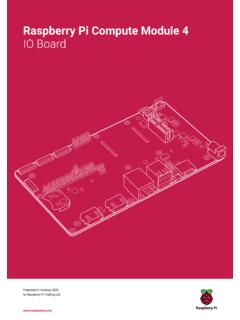Transcription of The ICD-IO Classifications of Injuries
1 The ICD-IO Classifications of Injuries and External Causes by L'Hours Introduction The Tenth Revision of the ICW published in 1992 is the most radical since the Sixth Revision in 1948 and in many respects represents a new classification rather than an updating of the previous revision that has been in use since 1977. The adoption of an alphanumeric coding scheme of one letter and two numbers at the three-character level with decimal subdivisions at the fourth character has almost doubled the size of the coding frame as compared to ICD-9. This has enabled new categories to be created for a number of entities with the fourth character being used for enhanced clinical and other detail.
2 Chapters XlX, Injury, poisoning and certain other consequences of external causes (using the letters S and T) and XX, External causes of morbidity and mortality (using the letters V, W, X and Y) have perhaps undergone the most change of all the 21 chapters of ICD--10 and both bring new taxonomic approaches that will result in easier and more accurate coding as well as facilitating the analysis and interpretation of the coded data. In drafting these two chapters, a conscious effort was made to maintain a clear distinction between the event itself (the external cause) and the effect on the individual (the injury or other consequence).
3 This was achieved by avoiding terminology related to the trauma in the external cause chapter and descriptions of the event in the injury chapter. There are however terms, such as drowning and electrocution, that are used to describe the cause as well as effect and these are used in both chapters. The expression ~rtain other consequences of external causes has been used in the title of chapter XIX. Some other consequences such as drug-induced and radiation-related disorders are included in other chapters, while other longer term consequences are better classified by the International Classification of Impairments, Disabilities, and Handicaps (ICIDH).
4 2 The view has been expressed that these two chapters could usefully serve as the basis for the development of an adaptation of ICD-10 for injury prevention. The Revision Process The broad lines of the Tenth Revision of the ICD were set at the Preparatory Meeting on ICD--10 held at the Headquarters of the World Health Organization (WHO) in Geneva, Switzerland from 12 to 16 September 1983. 3 The meeting recommended an alphanumeric coding scheme for ICD-10 of one letter and two numbers at the three-character level with numeric subdivisions where necessary to form the fourth-character level.
5 The full range of codes therefore runs from to "Ihe first Expert Committee on ICD-104 met in San Francisco in June 1984 and the first draft proposal for ICD--10 s containing only the three--character codes and rifles was circulated to WHO Member States, Nongovernmental Organizations in official relations with WHO, WHO Collaborating Centres for Classification of Diseases, and other interested groups and individuals in August 1984. Comments were requested by the end of January 1985. The second draft proposal for ICD--10 6 containing both the three-- and four-character codes and titles was circulated, on the same basis as the first draft, in August 1986 and comments were requested by 15 January 1987.
6 22-1 The chapter on External causes of morbidity and mortality 7 however was not circulated until September 1986 and comments were requested by 15 March 1987. At the Second Expert Committee on ICD--108 held in Geneva in November 1987, a full draft proposal containing three- and four--character titles with inclusion and exclusion terms was presented for the first time. Throughout the revision process, WHO received valuable advice and guidance from the annual meetings of the llcads of WHO Collaborating Centers for Classification of Diseases. The Centers are located in institutions in Canberra, Australia; Sao Paulo, Brazil; Beijing, China; London, England; Le V6sinet, France; Moscow, Russian Federation; Uppsala, Sweden; Hyattsville, USA; and Caracas, Venezuela.
7 At their annual meetings, the Centre Heads are also joined by representatives of the Dutch National Committee for Classification and Coding and the Office of the ICD, Japan. The International Conference for the Tenth Revision of the International Classification of Diseases, 9 attended by delegates from 43 Member States, was held in Geneva from 26 September to 2 October 1989. Following approval by the WHO Executive board and the World Health Assembly in 1990, Volume 1 of ICD-10 was published in 1992 and the classification came into use in two countries in 1994.
8 Several other countries will adopt it in 1995. Chapter XIX: Injury, Poisoning and Certain Other Consequences of External Causes At the meeting of Heads of WHO Collaborating Centers for Classification of Diseases held in San Francisco from 29 May to 4 June 1984, two separate proposals for the revision of the chapter related to Injuries were presented. One, prepared by the WltO Unit responsible for coordinating the periodic revision of the ICD, ~ followed the traditional approach of using the type of injury as the main axis of classification at the level of the blocks of categories with the site of involvement being identified at the three and four-character levels.
9 The other, undertaken by the Accident Analysis Group of Odense University Hospital, I)enmark," took into account suggestions made by the WHO Joint EURO/Global Steering Committee on the Development of Indicators for Accidents. The proposal was incompletely elaborated in that it covered only Injuries in its biaxial classification using body region and type of injury with no provision being made for Injuries of unspecified site. Also the proposal had not been discussed with the Nordic Medico Statistical Committee (NOMESCO) and it was thought that some Scandinavian countries would have preferred the traditional approach.
10 The Centre Heads recommended '2 that the proposal following the traditional approach, which had changed little over successive revisions, should form the basis for the injury chapter in the first lormal draft proposal Ior ICD-10. 5 This reconunendation was endorsed by the First Expert Committee on ICD--10. 4 At their meeting in Sao Paulo, Brazil in April 1985, the Centre Heads heard that, at its meeting in Reykjavik in August 1984, the WHO Joint EURO/Global Steering Committee on the Development of Indicators for Accidents had requested that the Centre lleads reconsider the rejection by both their group and the Expert Committee of the draft chapter on Injury and Poisoning.

















